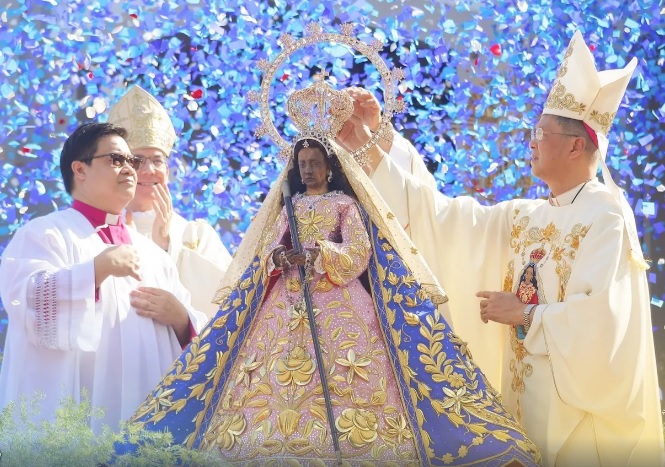Antipolo, Our Lady of Migrants international shrine
In the presence of 80 Filipino bishops the solemn liturgy with the proclamation of the title granted by the Vatican. Here the Virgin is venerated as "Our Lady of Peace and Good Journey". It becomes the first international shrine in South-East Asia and the third in the entire continent.
Antipolo (AsiaNews) – The Catholic Church in the Philippines yesterday experienced a historic day with the solemn liturgy of the proclamation of the cathedral of Antipolo as an international sanctuary.
The church houses an ancient statue of the Virgin, which arrived here from Mexico in the 17th century and venerated with the title of Our Lady of Peace and Good Voyage. For this reason she is very dear to the devotion of Filipino migrants all over the world.
With the recognition granted by the Vatican - which accepted a request made by the Catholic Bishops' Conference of the Philippines in 2021 - the Antipolo Cathedral has become the first international sanctuary in the Philippines and in all of Southeast Asia.
There are currently only 3 international sanctuaries in Asia and the Philippine one is the only one linked to Marian devotion: the other two are in fact the church of St. Thomas in Kerala and that of the Martyrs in Haemi, South Korea.
The proclamation of the title of international sanctuary took place yesterday during a solemn Eucharistic celebration presided over by the apostolic nuncio, Archbishop Charles John Brown, together with the bishop of Antipolo, Msgr. Ruperto Santos and 80 other bishops from all over the country. Among the many faithful present was also the First Lady of the Philippines, Louise Araneta-Marcos.
In his homily, the nuncio underlined the significance of this event as a testimony to the "internationality of the Philippine Catholic Church", underlining the role of the Virgin of Antipolo for migrants who pray for safety on their journeys.
“You bring a gift to the world and Our Lady here in Antipolo is truly the mother of this gift, because that gift is Jesus,” he said, linking the Filipino diaspora in evangelization.
“We pray and hope to be a blessing for everyone, to be his channels of grace and instruments of God's goodness for others,” Bishop Santos said for his part. "This will be our mandate and our mission from now on, so that this is a sanctuary of conversion, compassion and charity", he added, inviting the sanctuary to stand especially alongside the "vulnerable and voiceless".
The church was built in 1632 as a sanctuary for the Virgin of Antipolo, first brought by Governor General Juan Niño de Tabora from Acapulco, Mexico. Despite the damage caused by repeated earthquakes, the sanctuary became a place of pilgrimage during the Spanish period. Even the young Jose Rizal, the Philippine national hero, remembered in his diaries that he had gone there as a pilgrim together with his father in 1868.
The title of Our Lady of Peace associated with the sanctuary is linked to the painful events experienced during the Second World War, when in 1944 the Japanese occupation troops transformed it into an arsenal.
It was the sacristan Procopio Ángeles who saved the image of the Virgin by hiding it in an empty petrol can buried underground. From there she would then arrive at the Quiapo church in Manila, thus escaping the American bombings.
Rebuilt after the war, the church was then proclaimed a national sanctuary in 1954, and then became the cathedral when the diocese of Antipolo was established in 1983.
11/08/2017 20:05
28/04/2021 17:44
17/11/2005
01/10/2021 15:16







.png)










